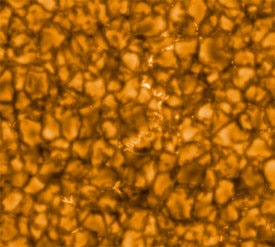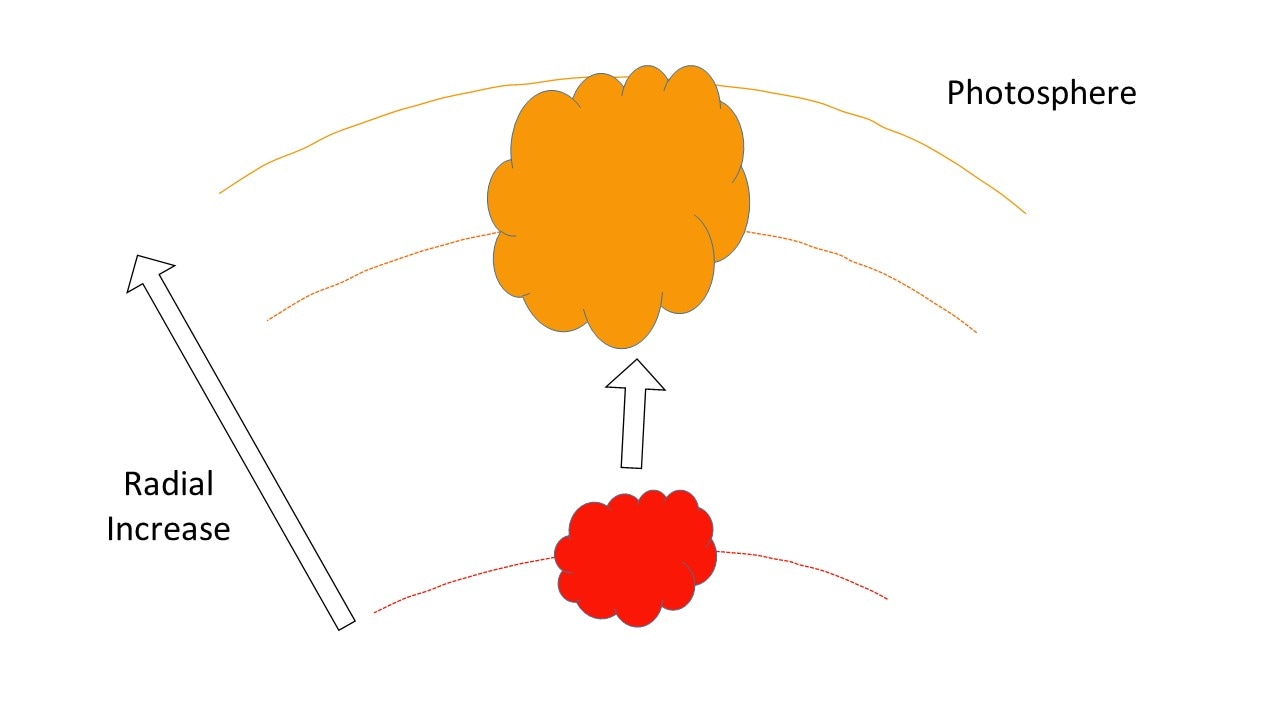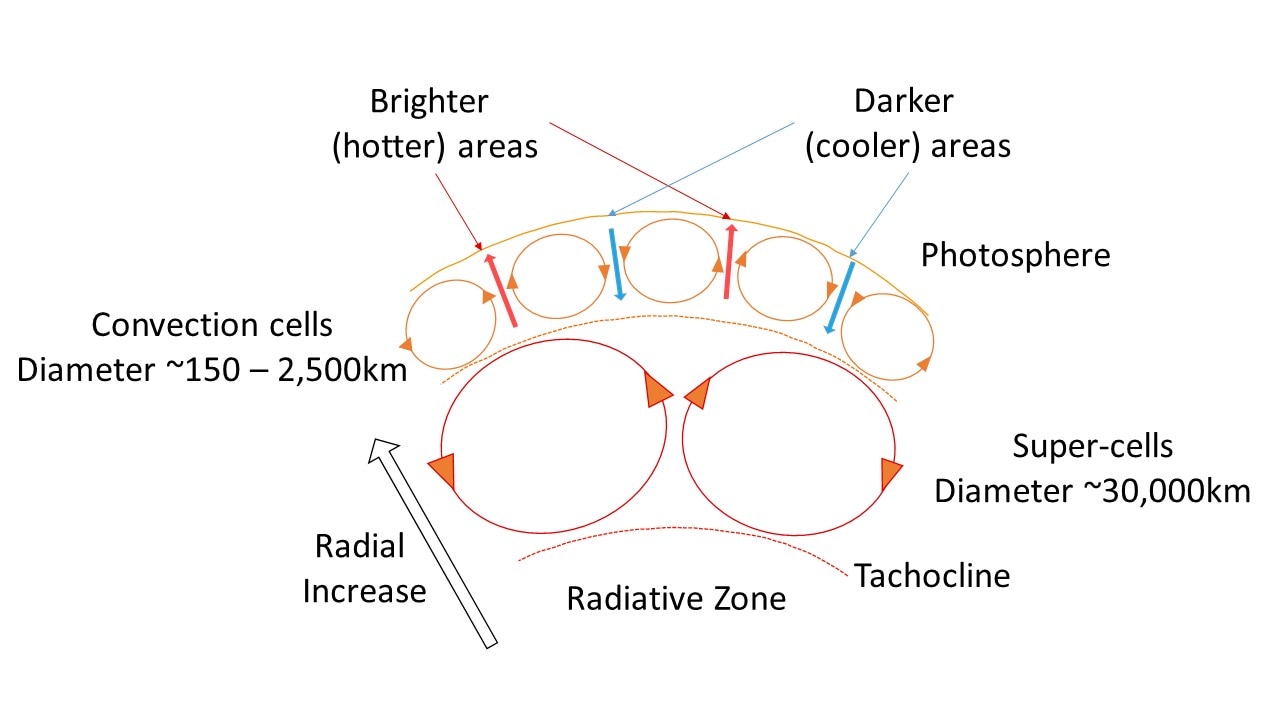This month we continue our series looking at the physics of the Sun. In May we looked at hydrostatic equilibrium and radiation transfer; today we look at convection processes in the Sun, how, why and where they occur, and how they produce the boiling/seething pattern known as Solar Granulation on the Sun’s photosphere.
Looking ahead to next month’s blog, we will take an interlude from Solar physics. In July we will be making another field visit to Rochechouart (in the Limousin region of France). At the end of the Triassic period (201 million years ago), this region was hit by an asteroid. Ahead of the launch in August of our publication on this devastating event, we will provide a short description of the event; the object that hit us; its effects; and the evidence that can still be seen today.
Ce mois nous continuons notre série d’articles sur la physique du Soleil. En mai nous avons considéré l’équilibre hydrostatique et le transfert de rayonnement. Aujourd’hui nous étudions le processus de convection du Soleil, et comment ce phénomène produit la granulation solaire (sur la photosphère) qui est visible à la surface du Soleil comme une structure de grains brillants (et chauds) cernés par des zones plus sombres et etroites, les intergranules .
Le mois prochain nous allons revisiter la ville de Rochechouart (en région Limousin). A la fin de Trias (il y a 201 millions d’années) un astéroïde est tombé sur la région. Avant la publication, en août, de notre livre sur cet événement nous allons donner une brève description de ce désastre et de ce qui reste de l’impact.
The Sun is in thermal equilibrium; the energy it produces is balanced by that which is radiated away; it is not cooling down or heating up. We know this because if the Sun was not in equilibrium, and the energy produced was not radiated away, then the pressure in the core would rise and the Sun would expand to such a size until hydrostatic equilibrium (see May 2017’s blog) was reached.
There are three ways in which energy can be transported from the core where it is produced to the exterior. These are:
- Conduction – the process whereby through atomic particle collisions, generally electrons, energy is transported to neighbouring material;
- Convection – where energy is carried by the physical movement of large scale masses in approximately circular ‘convection’ currents; and
- Radiation – where (electromagnetic spectrum) photons carry energy and interact with atoms encountered along their paths.
Within the Sun, radiation and convection are the dominant mechanisms for energy transport and conduction is at best a 2nd order effect. This is because conduction is particularly prevalent in high density material and where electron energy shells are full, e.g. material is non-ionic and/or degenerate; and hence interaction between particles is collisional rather than (electron) absorption based.
The gaseous nature of the Sun means that conduction isn’t an efficient process as the matter has a relatively low opacity (high transparency) and thus radiation can flow more easily than in high density, opaque, matter. Whilst there is a high density at the core of the Sun (about 20 times that of iron), and a high radiative opacity, because the matter is almost entirely ionised, any free electron movements lead to the electrons being captured in the atom’s electron energy shells. The electron “mean-free path” (again see May 2017’s blog) is very low for electrons within the Sun.
Whilst conduction is not an important process in our Sun, it does become dominant in the end-stages of stellar evolution and when stars become degenerate. White dwarf stars – which our Sun will eventually evolve to become – are degenerate stars wherein conduction is the primary means of energy transport. However, for now we will only consider radiation and convection energy transport.
We saw in last month’s blog how radiation is transported from the core to the photosphere. The temperature at the centre of the Sun is around 16 million Celsius whilst at the photosphere it is close to 6000. We can mathematically model the temperature gradient based on radiation processes (we do this in our book on the Sun but won’t make an involved topic too difficult here!)
We know from our own experiences that convection is a very much more efficient energy transport system than radiation. This can be seen by the example of using a candle. If you put your hand near the side of the flame (where you are only receiving heat by radiation), you can keep it there a long time. Try putting you hand directly above the flame (where both radiation and convection are happening) and you’ll quickly move it away!
Convection also occurs on a large scale within the Sun. It is the process whereby cells, ‘bubbles’ of hot gas, rise from the deeper hotter layers into the cooler upper regions of the Sun. We can see these cells appearing on the Sun’s photosphere (the apparent ‘surface’ of the Sun) as ‘solar granulation’. The picture below shows the granulation in an image taken by the NASA Hinode satellite, although granulation can also clearly be seen in most astronomical pictures of the Sun.
The brighter areas are hot (and hence brighter) cells rising into the photosphere. These are separated by the darker ‘lanes’ which is where the cooler material is descending back into the convection zone.
Convection occurs when a bubble of hot gas is displaced from its position within the convective zone. The bubble (which we will refer to as a cell) is hotter material than material at higher levels and thus is less dense. Its relative lower density will mean that it rises within the convection zone towards the photosphere. If the ascendency is rapid, no heat loss or gain from the cell will occur, i.e. no energy (heat) will be transferred into or out of the cell and the process will be what is known as Adiabatic.
The rate of change (the reduction) of the (cell) material temperature is called the adiabatic temperature change. For convection to take place, the temperature of the environment into which the cell moves must be less than the (initial/internal) temperature of the cell.
As we move outwards from the Sun’s core, the temperature reduces. The temperature (energy) due to radiation declines, as also does the heat transfer due to convection. The different ‘rates’ (gradients) in which the temperature reduces from each of these is important. If the ‘radiation temperature’ is greater than the ‘convection temperature’, then convection cannot take place and radiation transfer will prevail. However, if the radiation temperature falls off quicker than the convection temperature reduces, then convection will be the dominant. The maths and physics surrounding this is explained in our book.
At a particular, distinct depth in the Sun, convection ‘takes-over’ from radiation as being the dominant energy transfer mechanism. This point is called the Tachocline.
Within the Sun, the granulation, convection cells, which we can observe on the photosphere vary in scale from diameters of 150 km to 2,500 km. However, ‘beneath’ these, helioseismology (the study of pressure and sound waves within the Sun) observations have shown that super-cells of up to 30,000 km in diameter also operate.
Further reading
More details on this topic at undergraduate level
The Sun – Shining light on the Solar System
Neil Taylor. Observatoire Solaire
http://www.observatoiresolaire.eu/solar-physics.html
An excellent graduate level description of the processes, and more, we have mentioned here
Astrophysics Processes
Hale Bradt. Cambridge University Press.
http://www.cambridge.org/gb/academic/subjects/astronomy/astrophysics/astrophysics-processes-physics-astronomical-phenomena?format=PB#contentsTabAnchor
Next month…
We take a short interlude from Solar physics to discuss the Limousin asteroid impact which happened at the transition of the Triassic and Jurassic periods. This devastating event coincided with a species mass extinction on Earth and we discuss the possible relationship between the two events.




